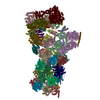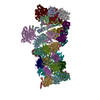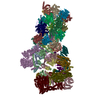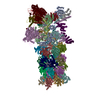[English] 日本語
 Yorodumi
Yorodumi- EMDB-49508: Structure of substrate engaged MIDN-bound human 26S proteasome, E... -
+ Open data
Open data
- Basic information
Basic information
| Entry |  | |||||||||
|---|---|---|---|---|---|---|---|---|---|---|
| Title | Structure of substrate engaged MIDN-bound human 26S proteasome, EB-MIDN (Composite map) | |||||||||
 Map data Map data | ||||||||||
 Sample Sample |
| |||||||||
 Keywords Keywords | Ubiquitin-indepedent / proteasome / Midnolin / MIDN-bound 26S complex / IMMUNE SYSTEM | |||||||||
| Function / homology |  Function and homology information Function and homology informationnegative regulation of glucokinase activity / Impaired BRCA2 translocation to the nucleus / Impaired BRCA2 binding to SEM1 (DSS1) / thyrotropin-releasing hormone receptor binding / nuclear proteasome complex / host-mediated perturbation of viral transcription / positive regulation of inclusion body assembly / Hydrolases; Acting on peptide bonds (peptidases); Omega peptidases / integrator complex / proteasome accessory complex ...negative regulation of glucokinase activity / Impaired BRCA2 translocation to the nucleus / Impaired BRCA2 binding to SEM1 (DSS1) / thyrotropin-releasing hormone receptor binding / nuclear proteasome complex / host-mediated perturbation of viral transcription / positive regulation of inclusion body assembly / Hydrolases; Acting on peptide bonds (peptidases); Omega peptidases / integrator complex / proteasome accessory complex / meiosis I / purine ribonucleoside triphosphate binding / proteasome regulatory particle / cytosolic proteasome complex / positive regulation of proteasomal protein catabolic process / proteasome-activating activity / proteasome regulatory particle, lid subcomplex / proteasome regulatory particle, base subcomplex / metal-dependent deubiquitinase activity / protein K63-linked deubiquitination / negative regulation of programmed cell death / Regulation of ornithine decarboxylase (ODC) / Proteasome assembly / Cross-presentation of soluble exogenous antigens (endosomes) / Homologous DNA Pairing and Strand Exchange / Defective homologous recombination repair (HRR) due to BRCA1 loss of function / Defective HDR through Homologous Recombination Repair (HRR) due to PALB2 loss of BRCA1 binding function / Defective HDR through Homologous Recombination Repair (HRR) due to PALB2 loss of BRCA2/RAD51/RAD51C binding function / Resolution of D-loop Structures through Synthesis-Dependent Strand Annealing (SDSA) / proteasome core complex / Resolution of D-loop Structures through Holliday Junction Intermediates / Somitogenesis / K63-linked deubiquitinase activity / proteasomal ubiquitin-independent protein catabolic process / Impaired BRCA2 binding to RAD51 / proteasome binding / transcription factor binding / regulation of protein catabolic process / myofibril / proteasome storage granule / Presynaptic phase of homologous DNA pairing and strand exchange / general transcription initiation factor binding / blastocyst development / polyubiquitin modification-dependent protein binding / protein deubiquitination / immune system process / NF-kappaB binding / proteasome endopeptidase complex / proteasome core complex, beta-subunit complex / endopeptidase activator activity / mRNA export from nucleus / proteasome assembly / threonine-type endopeptidase activity / proteasome core complex, alpha-subunit complex / enzyme regulator activity / regulation of proteasomal protein catabolic process / inclusion body / proteasome complex / TBP-class protein binding / proteolysis involved in protein catabolic process / sarcomere / Regulation of activated PAK-2p34 by proteasome mediated degradation / Autodegradation of Cdh1 by Cdh1:APC/C / APC/C:Cdc20 mediated degradation of Securin / N-glycan trimming in the ER and Calnexin/Calreticulin cycle / Asymmetric localization of PCP proteins / Ubiquitin-dependent degradation of Cyclin D / SCF-beta-TrCP mediated degradation of Emi1 / NIK-->noncanonical NF-kB signaling / TNFR2 non-canonical NF-kB pathway / AUF1 (hnRNP D0) binds and destabilizes mRNA / stem cell differentiation / Vpu mediated degradation of CD4 / Assembly of the pre-replicative complex / Ubiquitin-Mediated Degradation of Phosphorylated Cdc25A / Degradation of DVL / Dectin-1 mediated noncanonical NF-kB signaling / Cdc20:Phospho-APC/C mediated degradation of Cyclin A / negative regulation of inflammatory response to antigenic stimulus / Degradation of AXIN / P-body / Hh mutants are degraded by ERAD / lipopolysaccharide binding / Activation of NF-kappaB in B cells / Degradation of GLI1 by the proteasome / G2/M Checkpoints / Hedgehog ligand biogenesis / GSK3B and BTRC:CUL1-mediated-degradation of NFE2L2 / Defective CFTR causes cystic fibrosis / Autodegradation of the E3 ubiquitin ligase COP1 / Negative regulation of NOTCH4 signaling / Regulation of RUNX3 expression and activity / Vif-mediated degradation of APOBEC3G / negative regulation of insulin secretion / Hedgehog 'on' state / FBXL7 down-regulates AURKA during mitotic entry and in early mitosis / Degradation of GLI2 by the proteasome / GLI3 is processed to GLI3R by the proteasome / APC/C:Cdh1 mediated degradation of Cdc20 and other APC/C:Cdh1 targeted proteins in late mitosis/early G1 / MAPK6/MAPK4 signaling Similarity search - Function | |||||||||
| Biological species |  Homo sapiens (human) Homo sapiens (human) | |||||||||
| Method | single particle reconstruction / cryo EM / Resolution: 2.8 Å | |||||||||
 Authors Authors | Peddada N / Beutler B | |||||||||
| Funding support |  United States, 2 items United States, 2 items
| |||||||||
 Citation Citation |  Journal: Proc Natl Acad Sci U S A / Year: 2025 Journal: Proc Natl Acad Sci U S A / Year: 2025Title: Structural insights into the ubiquitin-independent midnolin-proteasome pathway. Authors: Nagesh Peddada / Xue Zhong / Yan Yin / Danielle Renee Lazaro / Jianhui Wang / Stephen Lyon / Jin Huk Choi / Xiao-Chen Bai / Eva Marie Y Moresco / Bruce Beutler /  Abstract: The protein midnolin (MIDN) augments proteasome activity in lymphocytes and dramatically facilitates the survival and proliferation of B-lymphoid malignancies. MIDN binds both to proteasomes and to ...The protein midnolin (MIDN) augments proteasome activity in lymphocytes and dramatically facilitates the survival and proliferation of B-lymphoid malignancies. MIDN binds both to proteasomes and to substrates, but the mode of interaction with the proteasome is unknown, and the mechanism by which MIDN facilitates substrate degradation in a ubiquitin-independent manner is incompletely understood. Here, we present cryoelectron microscopy (cryo-EM) structures of the substrate-engaged, MIDN-bound human proteasome in two conformational states. MIDN induces proteasome conformations similarly to ubiquitinated substrates by using its ubiquitin-like domain to bind to the deubiquitinase RPN11 (PSMD14). By simultaneously binding to RPN1 (PSMD2) with its C-terminal α-helix, MIDN positions its substrate-carrying Catch domain above the proteasome ATPase channel through which substrates are translocated before degradation. Our findings suggest that both ubiquitin-like domain and C-terminal α-helix must bind to the proteasome for MIDN to stimulate proteasome activity. | |||||||||
| History |
|
- Structure visualization
Structure visualization
| Supplemental images |
|---|
- Downloads & links
Downloads & links
-EMDB archive
| Map data |  emd_49508.map.gz emd_49508.map.gz | 474.6 MB |  EMDB map data format EMDB map data format | |
|---|---|---|---|---|
| Header (meta data) |  emd-49508-v30.xml emd-49508-v30.xml emd-49508.xml emd-49508.xml | 58.9 KB 58.9 KB | Display Display |  EMDB header EMDB header |
| Images |  emd_49508.png emd_49508.png | 76.3 KB | ||
| Filedesc metadata |  emd-49508.cif.gz emd-49508.cif.gz | 16.2 KB | ||
| Archive directory |  http://ftp.pdbj.org/pub/emdb/structures/EMD-49508 http://ftp.pdbj.org/pub/emdb/structures/EMD-49508 ftp://ftp.pdbj.org/pub/emdb/structures/EMD-49508 ftp://ftp.pdbj.org/pub/emdb/structures/EMD-49508 | HTTPS FTP |
-Validation report
| Summary document |  emd_49508_validation.pdf.gz emd_49508_validation.pdf.gz | 468.2 KB | Display |  EMDB validaton report EMDB validaton report |
|---|---|---|---|---|
| Full document |  emd_49508_full_validation.pdf.gz emd_49508_full_validation.pdf.gz | 467.8 KB | Display | |
| Data in XML |  emd_49508_validation.xml.gz emd_49508_validation.xml.gz | 8.8 KB | Display | |
| Data in CIF |  emd_49508_validation.cif.gz emd_49508_validation.cif.gz | 10.4 KB | Display | |
| Arichive directory |  https://ftp.pdbj.org/pub/emdb/validation_reports/EMD-49508 https://ftp.pdbj.org/pub/emdb/validation_reports/EMD-49508 ftp://ftp.pdbj.org/pub/emdb/validation_reports/EMD-49508 ftp://ftp.pdbj.org/pub/emdb/validation_reports/EMD-49508 | HTTPS FTP |
-Related structure data
| Related structure data |  9nkgMC  9nkfC  9nkiC  9nkjC C: citing same article ( M: atomic model generated by this map |
|---|---|
| Similar structure data | Similarity search - Function & homology  F&H Search F&H Search |
- Links
Links
| EMDB pages |  EMDB (EBI/PDBe) / EMDB (EBI/PDBe) /  EMDataResource EMDataResource |
|---|---|
| Related items in Molecule of the Month |
- Map
Map
| File |  Download / File: emd_49508.map.gz / Format: CCP4 / Size: 1000 MB / Type: IMAGE STORED AS FLOATING POINT NUMBER (4 BYTES) Download / File: emd_49508.map.gz / Format: CCP4 / Size: 1000 MB / Type: IMAGE STORED AS FLOATING POINT NUMBER (4 BYTES) | ||||||||||||||||||||||||||||||||||||
|---|---|---|---|---|---|---|---|---|---|---|---|---|---|---|---|---|---|---|---|---|---|---|---|---|---|---|---|---|---|---|---|---|---|---|---|---|---|
| Projections & slices | Image control
Images are generated by Spider. | ||||||||||||||||||||||||||||||||||||
| Voxel size | X=Y=Z: 1.074 Å | ||||||||||||||||||||||||||||||||||||
| Density |
| ||||||||||||||||||||||||||||||||||||
| Symmetry | Space group: 1 | ||||||||||||||||||||||||||||||||||||
| Details | EMDB XML:
|
-Supplemental data
- Sample components
Sample components
+Entire : Structure of MIDN-bound human 26S proteasome in substrate engaged...
+Supramolecule #1: Structure of MIDN-bound human 26S proteasome in substrate engaged...
+Macromolecule #1: Proteasome subunit alpha type-6
+Macromolecule #2: Proteasome subunit alpha type-2
+Macromolecule #3: Proteasome subunit alpha type-4
+Macromolecule #4: Proteasome subunit alpha type-7
+Macromolecule #5: Proteasome subunit alpha type-5
+Macromolecule #6: Proteasome subunit alpha type-1
+Macromolecule #7: Proteasome subunit alpha type-3
+Macromolecule #8: Proteasome subunit beta type-6
+Macromolecule #9: Proteasome subunit beta type-7
+Macromolecule #10: Proteasome subunit beta type-3
+Macromolecule #11: Proteasome subunit beta type-2
+Macromolecule #12: Proteasome subunit beta type-5
+Macromolecule #13: Proteasome subunit beta type-1
+Macromolecule #14: Proteasome subunit beta type-4
+Macromolecule #15: 26S proteasome regulatory subunit 7
+Macromolecule #16: 26S proteasome regulatory subunit 4
+Macromolecule #17: 26S protease regulatory subunit 8
+Macromolecule #18: 26S proteasome regulatory subunit 6B
+Macromolecule #19: 26S proteasome regulatory subunit 10B
+Macromolecule #20: 26S proteasome regulatory subunit 6A
+Macromolecule #21: 26S proteasome non-ATPase regulatory subunit 3
+Macromolecule #22: 26S proteasome non-ATPase regulatory subunit 12
+Macromolecule #23: 26S proteasome non-ATPase regulatory subunit 11
+Macromolecule #24: 26S proteasome non-ATPase regulatory subunit 6
+Macromolecule #25: 26S proteasome non-ATPase regulatory subunit 7
+Macromolecule #26: 26S proteasome non-ATPase regulatory subunit 13
+Macromolecule #27: 26S proteasome non-ATPase regulatory subunit 4
+Macromolecule #28: 26S proteasome non-ATPase regulatory subunit 8
+Macromolecule #29: 26S proteasome complex subunit SEM1
+Macromolecule #30: unknown density (substrate density)
+Macromolecule #31: 26S proteasome non-ATPase regulatory subunit 1
+Macromolecule #32: 26S proteasome non-ATPase regulatory subunit 14
+Macromolecule #33: 26S proteasome non-ATPase regulatory subunit 2
+Macromolecule #34: Midnolin
+Macromolecule #35: N-[(benzyloxy)carbonyl]-L-leucyl-N-[(2S)-4-methyl-1-oxopentan-2-y...
+Macromolecule #36: ADENOSINE-5'-TRIPHOSPHATE
+Macromolecule #37: MAGNESIUM ION
+Macromolecule #38: ADENOSINE-5'-DIPHOSPHATE
+Macromolecule #39: ZINC ION
-Experimental details
-Structure determination
| Method | cryo EM |
|---|---|
 Processing Processing | single particle reconstruction |
| Aggregation state | particle |
- Sample preparation
Sample preparation
| Buffer | pH: 7.6 Details: 50 mM Tris, pH 7.5, 150 mM NaCl, 20 mM KCl,5 mM MgCl2, 1 mM TECP, |
|---|---|
| Grid | Model: Quantifoil R1.2/1.3 / Material: COPPER / Mesh: 300 / Pretreatment - Type: GLOW DISCHARGE / Pretreatment - Time: 80 sec. / Details: 30mA |
| Vitrification | Cryogen name: ETHANE / Chamber humidity: 100 % / Chamber temperature: 277 K / Instrument: FEI VITROBOT MARK IV |
| Details | In Vitro Reconstituted MIDN-26S proteasome complex |
- Electron microscopy
Electron microscopy
| Microscope | TFS KRIOS |
|---|---|
| Specialist optics | Energy filter - Name: GIF Bioquantum |
| Image recording | Film or detector model: GATAN K3 BIOQUANTUM (6k x 4k) / Number grids imaged: 3 / Number real images: 20794 / Average electron dose: 50.0 e/Å2 |
| Electron beam | Acceleration voltage: 300 kV / Electron source:  FIELD EMISSION GUN FIELD EMISSION GUN |
| Electron optics | C2 aperture diameter: 70.0 µm / Illumination mode: FLOOD BEAM / Imaging mode: BRIGHT FIELD / Cs: 2.7 mm / Nominal defocus max: 2.7 µm / Nominal defocus min: 1.1 µm / Nominal magnification: 81000 |
| Sample stage | Specimen holder model: FEI TITAN KRIOS AUTOGRID HOLDER |
| Experimental equipment |  Model: Titan Krios / Image courtesy: FEI Company |
 Movie
Movie Controller
Controller




























 Z (Sec.)
Z (Sec.) Y (Row.)
Y (Row.) X (Col.)
X (Col.)

























